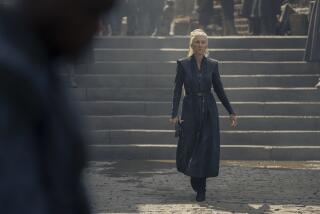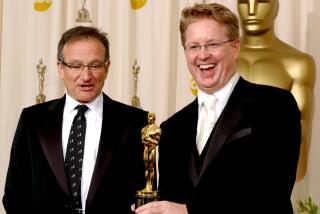âHow to Train Your Dragonâ and a baptism of fire
Animated movies can take forever to make -- three or four years is well within the ordinary. âHow to Train Your Dragon,â which tells the story of a scrawny kid destined to prove his hecklers wrong through an unusual relationship with a dragon, moved at a radically different pace: the two filmmakers behind March 26âs 3-D adventure had just 12 months to make their film, inheriting a project needing a top-to-bottom overhaul.
Pressed for time, writer-directors Dean DeBlois and Chris Sanders (the team behind 2002âs âLilo & Stitchâ) tried to avoid some of the pitfalls -- such as polishing a joke to within an inch of its life -- that an unhurried production schedule often engenders. âItâs a model that allows for too much indecision,â DeBlois says of the often endless stops and starts that are part of the time- table for most animated movies. âYou can get into a situation where the only thing that 30 people in a room can agree on is a clichĂŠ.â
While reviewers have yet to weigh in on the artistic merits of the DreamWorks Animation production, âHow to Train Your Dragonâ feels unlike some of the studioâs previous animated movies, particularly a few of its star-driven movies ( Jerry Seinfeldâs âBee Movie,â Will Smithâs âShark Tale,â Brad Pittâs âSinbad: Legend of the Seven Seasâ) that were critically battered for having more concept and celebrity than originality and heart. âHow to Train Your Dragon,â in other words, plays like a directorâs movie, not a committeeâs.
âChris and Dean,â says Bill Damaschke, co-president of production for DreamWorks animation, âare part of an overall shift in what weâre trying to do.â
Loosely based on Cressida Cowellâs childrenâs book, the approximately $165-million âDragonâ is the first release in a potentially landmark year for the animation studio, which will introduce two other features before 2010 is over: May 21âs âShrek Forever Afterâ and Nov. 5âs âMegamind.â Itâs the first time Jeffrey Katzenbergâs studio has released three movies in a year (having only one film, âMonsters vs. Aliens,â in 2009), as DreamWorks increases its output to five movies every two years.
Extensive story and character renovations and director replacements are scarcely unique to animated movies at DreamWorks. Brad Bird was not the original director of Pixarâs âRatatouilleâ (he took over from Jan Pinkava), John Lasseter replaced Ash Brannon on Pixarâs âToy Story 2,â Glen Keane left Disneyâs upcoming âTangledâ and was replaced by Nathan Greno and Byron Howard, and Sanders was the original director of Disneyâs âAmerican Dog,â the movie that became Howard and Chris Williamsâ â Bolt.â
But rarely has the clock been ticking as fast as it was on âHow to Train Your Dragon.â
Walt Disneyâs creative vision was that there is a child inside everyone no matter his or her age. Particularly in its modern classic animated titles, the studio he founded packed films with youthful protagonists: Simba in âThe Lion King,â Ariel in âThe Little Mermaid,â Jasmine in âAladdinâ to name but a few. Under Katzenberg, the 16-year-old DreamWorks (whose animation division went public in 2004) turned Disneyâs notion on its head, populating its animated movies with adults (Shrek being the prime example) who might appeal to children.
Cowellâs novel about Vikings and their complicated relationship with dragons, however, is filled with pre-pubescent kids, a perfect book for second-graders. In the studioâs efforts to remain true to her reluctant hero story, original director Peter Hastings (who made âThe Country Bearsâ and has TV credits on âPinky and the Brainâ and âAnimaniacsâ) assembled a movie that in DreamWorksâ view played more to the âSpongeBob SquarePantsâ crowd than followers of â Harry Potter.â
In an era when more and more families attend sometimes intense movies together -- âAvatar,â â Spider-Manâ -- the initial version of âHow to Train Your Dragonâ felt too young to the studio: the kind of movie for which parents drop off their kids but do not attend themselves.
âIt was a little small and personal story, and I think thatâs the way Cressida wrote it,â says Bonnie Arnold ( âToy Story,â âOver the Hedgeâ), the filmâs producer. As the studio saw it, that faithfulness became a perceived liability: If âDragonâ didnât have older characters and more ambitious action scenes, its audience would become limited and it would suffer at the box office. âIt was not a universal story that everyone would love,â Damaschke says.
Sanders, having left Disney after 2006âs Pixar deal (which put his âAmerican Dogâ under new bosses), already was at DreamWorks and had spent a year directing the prehistoric story âThe Croods.â Damaschke thought Sanders would be a good choice to replace Hastings (whose talent agency did not return a call seeking comment). âI didnât know anything specific about the story,â Sanders says. âI just had a good feeling about it.â He set aside âThe Croods,â which will now come out a year later than originally scheduled, in March 2012.
It was October 2008, and although âHow to Train Your Dragonâ previously had been moved from November 2009 to March 2010 (largely to steer clear of âAvatarâ), Sanders didnât have a minute to lose; DreamWorks, confident it made good sense to release three movies this year, worried that if the film wasnât ready by March it would slip all the way to 2011. Even when every scene in an animated movie is written, storyboarded and animated, it takes months more to finish the filmâs lighting, scoring and sound mixing, meaning that Sanders had just a year to remake it.
One of Sandersâ first calls was to DeBlois, his âLilo & Stitchâ collaborator, who was in Seattle, trying to kick-start several live-action movies that he would write and direct. âChris said, âWhat are you doing right now?â â DeBlois recalls. âI bought a plane ticket. And we started that week.â
Not enough conflict
In tracking the book, the original version of the film not only featured younger characters (led by a far-from-fearless boy named Hiccup) but also followed very different rules of engagement between the 8th century occupants of the Island of Berk and the neighboring fire-breathing reptiles.
The novel and the early movie version had the North Sea residents and the dragons intermingling; in place of warfare was cooperation. âWe felt there wasnât enough peril,â DeBlois says.
In Hastingsâ movie, the young children collect dragon eggs and raise them to do tricks. In Sanders and DeBloisâ version, Berk is under attack from the dragons, who steal the remote villageâs livestock and burn its homes.
âWe had to decide that they were enemies. Itâs a deadly relationship. And Hiccup would be the first one to cross that line,â Sanders says. While Sanders and DeBlois retained many of the original movie versionâs characters and the actors who played them, they made substantive changes to their ages and size.
Hiccup (voiced by âTropic Thunderâsâ Jay Baruchel) and his romantic interest, Astrid (âUgly Bettyâsâ America Ferrera), matured from about 10 years old to nearly 17. The storyâs central dragon, Toothless, also grew exponentially, from a small and cuddly pet into a formidable, flyable beast. (Rather than dispatch the original incarnations to the animation scrap heap, Sanders and DeBlois instead gave the three characters as first animated a couple of cameos. Toothless as he was initially envisioned is now a small dragon who appears early in the film, trying to steal food from the new Toothless, only to be sent away with a blast of fire. The first Hiccup and Astrid are now small children in a womanâs arms who turn up late in the film as Toothless leaves in a boat.) At the same time, the relationship between Hiccup and his disappointed warrior father, Stoick the Vast ( Gerard Butler) grew more central to the plot.
Required to make decisions and never second-guess them (âEveryone knew that time was running out,â Sanders says), the filmmakers put together a large poster laying out storytelling themes that could not be violated as they rewrote and reshot the film:
* âAt its core, this is a story about a son and his father.â
* âA story where the sonâs weakness becomes his greatest strength.â
* âA story where the littlest guy will defeat the biggest thing the Vikings have ever seen.â
The filmmakers made any number of small changes -- patterning the dragonsâ flying on fighter planes, bringing in cinematographer Roger Deakins (impressed by his work on âThe Assassination of Jesse James by the Coward Robert Fordâ and other films) as a consultant to give the film more cinematic lighting -- as they raced toward their release date.
âYouâre making a leap of faith when you have so little time,â producer Arnold says. âWe let them run with it.â
More to Read
Only good movies
Get the Indie Focus newsletter, Mark Olsen's weekly guide to the world of cinema.
You may occasionally receive promotional content from the Los Angeles Times.











